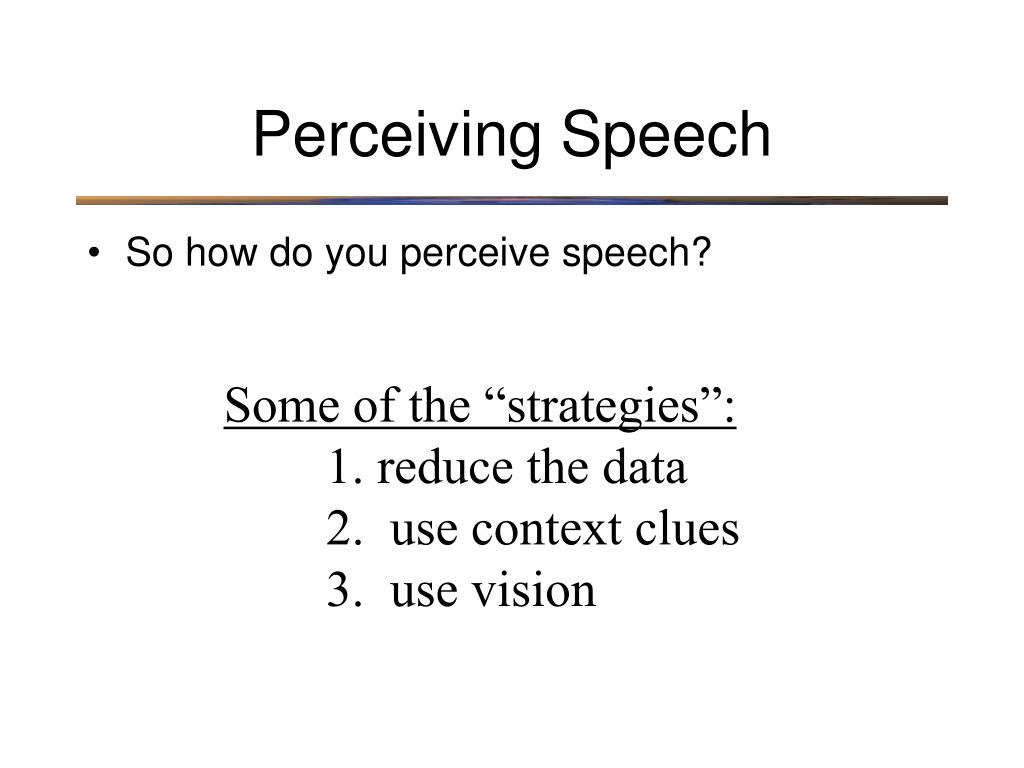

The outcome of the recognition process is the transformation of the pre-perceptual auditory image of the sound stimulus into a synthesized percept held in synthesized auditory memory.Īccording to this model, pre-perceptual auditory storage can hold only one sound pattern at a time for a short temporal period. The recognition process operates to find the prototype in long-term memory which best describes the acoustic features in pre-perceptual auditory storage.

As each sound pattern is presented, its corresponding acoustic features are held in pre-perceptual auditory storage. The prototype contains a list of acoustic features that define the properties of the sound pattern as they would be represented in pre-perceptual auditory storage. One reasonable assumption is that every perceptual unit in speech has a representation in long-term memory, which is called a prototype. One issue given this framework is, what are the patterns that are functional in the recognition of speech? These sound patterns are referred to as perceptual units. The recognition process transforms the pre-perceptual image into a synthesized percept. Based on my backward masking experiments and other experimental paradigms, this storage holds the information in a pre-perceptual form for roughly 250 ms, during which time the recognition process must take place.
SPEECH PERCEPTION DEFINITION CODE
An auditory stimulus is transformed by the auditory receptor system and sets up a neurological code in a pre-perceptual auditory storage. Given some speech input, the perceiver must determine which message best describes the input. Speech perception can be described as a pattern-recognition problem. By this time, my research and research by others indicated the syllable and the letter as units in speech and print, respectively. Inherent to the model were prototypes in memory and, therefore, it was important to take a stance on perceptual units in speech and print. Gregg Oden and I collaborated to formulate a fuzzy logical model of perception (Oden & Massaro, 1978 Movellan & McClelland, 2001), which has served as a framework for my research to this day. Previous research had manipulated only a single variable in these fields, and our empirical work manipulated multiple sources of both bottom-up and top-down information. My own research interests also expanded to include the study of reading and speech perception. We learned that previous work in this area had failed to address the issues described above, and our theoretical framework and empirical reviews anticipated much of the research in psycholinguistics since that time in which the focus is on real-time on-line processing (see our book entitled, Understanding Language: An Information Processing Analysis of Speech Perception, Reading and Psycholinguistics, 1975) I held a graduate seminar for three years with the purpose of applying the approach to language processing.

Initiating my career as a faculty member, I looked to apply this information-processing approach to a more substantive domain of behavior. The research led to a theory of perception and memory processes that revealed the properties of pre-perceptual and perceptual memory stores and rules for interference of information in these stores and theories of forgetting (Massaro, 1970). My early studies involved a delineation of perception and memory processes in the processing of speech and music.

Two important implications arose from this approach: 1) the proximal influences on behavior and 2) the time course of processing are central to a complete description of behavior (as opposed to simple environment-behavior relationships. I relied mostly on my writings in the literature rather than undocumented memory.ĭuring my graduate studies in mathematical and experimental psychology and also during my postdoctoral position, I developed an information-processing approach to the study of behavior (see Massaro & Cowan, 1993, for this brand of information processing). Some reminiscences on how I was led to propose the syllable as the perceptual unit in speech perception. He graciously agreed to do this for us and here it is. Given that there have been some interesting debates here on Talking Brains regarding the basic unit of speech perception, I asked Dom Massaro, a prominent and long-time player in this debate, to put together a comment on the topic for publication here. The following was originally posted to Talking Brains.


 0 kommentar(er)
0 kommentar(er)
